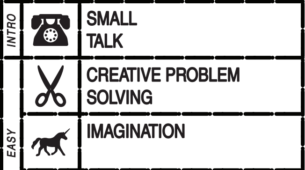The game I chose for its overlap of game mechanics is Wing it. Both of these games involve winning through providing an open ended responses to a prompt. However, there are many mechanical differences that differentiate these two games. We are hoping that our game design improves upon a couple pain points of the design of Wing It.
Wing It is similar to Cards Against Humanity in that there is a singular judge per round, and all of the players get a chance to craft a narrative using three resources to solve the challenge at hand. I played this game with Haven and some other members of the class during Thursday’s Game Night, and it was indeed a whole lot of fun. It is a very verbal-forward game, where you win by being the funniest or subverting the most expectations. For instance, I solved a hypothetical scenario involving a flooding room using one of my cards which was a gravity reversing machine. While I think I often had the resources with which I could have won, I think at least one reason I didn’t is because my stories didn’t have cohesive usage of humor, or perhaps that as a new member, it took me a little bit of time to understand different people’s individual humor or the group humor as a whole. This game is played very differently across different groups, and does require a learning curve to both this style of story-driven game and about learning how to appeal to other player’s humors and interests. An issue with this game is that the rounds became very long; since players are rewarded by their skill in managing the tension and everything else of their story, the stories became much less about the cards and more just about the verbal ability to gain a reaction using the supporting cast of the story. All in all though, I did find it very entertaining to play and I want to improve my storytelling and planning for the next time I get to play 😀
In comparison, there are many mechanical differences of our game, entitled Masquerade. In this game, all players respond to a random prompt and a random ‘style’ of answer. Rather than relying on verbal responses, respondents give an anonymous, text responses to a question. This level of anonymity serves several purposes; the scoring revolves instead around trying to identify which player guessed which response. The idea behind why this might better serve intimate players is that it doesn’t require close friends to assign a relative value judgement on the quality of their responses; instead, players learn more about the other players and get rewarded for understanding the aspects of each person’s self presentation and humor. There is also a symmetric nature to our game: there isn’t a singular judge, and all players are responding and guessing simultaneously. We are also experimenting with a new feature where the prompt/answer combo is selected from sets of three by a rotating pair of players. This way there can be a higher rate of question and answer choices that players enjoy, while not leaving it up entirely to their agency. We are also working on a timer so players feel a sense of pressure in getting through some phases that might otherwise feel like they take too long. Finally, to make the ‘style’ non mandatory, players instead get a point themselves for simply following the modifier. This way players don’t feel stuck if they can’t answer the given question with the constraint.
Overall, the set of mechanics that we employ seek to improve the speed of play and add a new scoring twist that should hopefully facilitate an entertaining and fresh game. While we didn’t design this game to be as easy to pick-up-and-play-with-a-new-group as Wing It, I think it still satisfies it’s own niche of desired interactivity for this genre of game.


